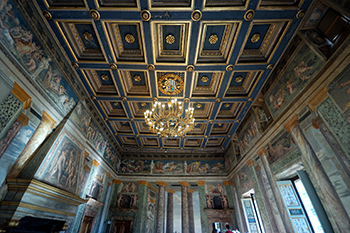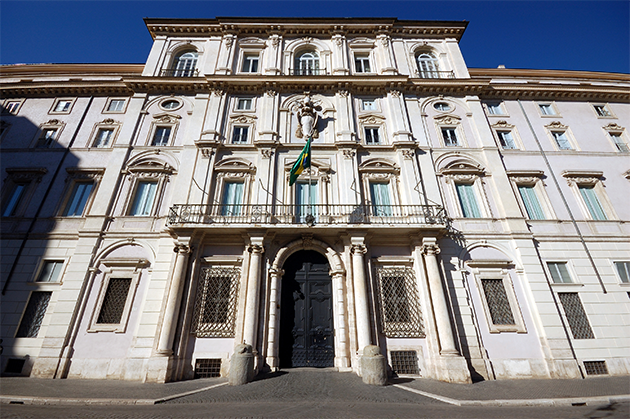
Who said Rome’s glorious past purely belongs to the BC time period? The Middle Ages and Renaissance years were filled with plots, gala parties and rivalries between noble families, and although it’s impossible to list them all, here are some of the most glamorous, powerful and scandalous clans — and ways you can walk in their elegant footsteps today.
The Pamphilj Family
Who Are They
The official end of the Pamphilj dynasty can be traced in 1760, when the last exponent died without sons and their fortune was handed over to the heir of Genoa’s Doria family by virtue of a previous wedding that linked the two houses.
A wealthy and influential family, it’s hard to mention the Pamphiljs without referring to the famous Olimpia Maidalchini (also known as Donna Olimpia or Olimpia Pamphili). Hailing from neighboring Viterbo, she wedded Pamphilio Pamphilj, and would have been a shrewd fixer today, but back in the 1600s she could only conspire, and achieve her goals, behind the scenes. Olimpia was arguably one of the most feared and hated women in all of Rome, although that never stopped her in the quest for more power and wealth. Resourceful like nobody else in the family, she played an important role in the ascension of her brother-in-law, Pope Innocent X, to the papal throne.
What Are They Known For
It is no secret that Olimpia was the undisputed ruler within the Holy See, the person to go to in order to have papal favors, and the real master behind the family’s opulence and prestige.
Her son, Camillo, was an art lover, and we owe him praise for providing the vision and financial resources behind some of the greatest buildings of 17th-century Rome, starting with their own Villa Pamphilj, the city’s largest park, and many churches such as the Basilica di San Nicola da Tolentino, near Piazza Barberini, the chapel of San Tommaso da Villanova in Sant’Agostino church, and Saint Andrew al Quirinale.
How You Can Visit Them
Despite their alleged sentimental relation, when Pope Innocent X died, Olimpia, his closest relative, refused to pay for his funeral, which was funded instead by his servants. This is why, according to the legend, every year, on the January 7th anniversary of the pope’s death, the ghost of Olimpia is seen running away from Piazza Navona on a chariot ablaze with fire while being chased by demons before disappearing in the Tiber from Ponte Sisto Bridge.
If you don’t happen to be in Rome around that terrifying time, you can still admire what the powerful family left behind by taking a stroll in the beautiful park Villa Doria Pamphili or in Piazza Navona, where the infamous Olimpia once lived and where the Brazilian embassy is now.
And for more famiglia sightseeing, check out Palazzo Doria-Pamphilj. When Camillo, the only person who ever dared to thwart his mother’s plans, got married instead of pursuing an ecclesiastical career, he moved to his bride’s dowry, which today is known as Palazzo Doria-Pamphilj, and is open to the public every day from 9 a.m. to 7 p.m.
Who Are They
Hailing from Siena, Tuscany, the Chigis were an influential Roman family and, like pretty much all prominent clans worthy of respect, they relied on a great number of cardinals and popes, such as Pope Alexander VII, born Fabio Chigi, to reach the apex of their glory.
One of their most popular family members was Agostino, a banker and philanthropist who lived more than a century before his relative, Alexander VII. After commissioning the beautiful Villa Farnesina in the heart of Trastevere, he hired Renaissance painter Raphael for its frescoes and the decoration of two churches, including Santa Maria del Popolo, where he’s buried.
What Are They Known For
At the height of his career, Raphael wasn’t really bent on accepting any work outside of the Vatican, unless the new client was as, if not more, powerful than the pope himself. Apparently, Agostino met the necessary requirements. It was around the time that he connected with Agostino that Raphael fell head over heels for a lower class woman, Margherita Luti, daughter of a local baker. This is when the wise Agostino decided to allow Luti into the villa in an effort to keep the lovers together and to avoid delays on Raphael’s work. And today, we can admire the artist’s masterpiece within.
Graciously fitting with the style of his ancestor Agostino, Pope Alexander VII also proved sensitive toward the world of art and architecture, encouraging it and even commissioning artist Gian Lorenzo Bernini to do the world famous forecourt at St. Peter’s Square.
How You Can Visit Them
If you are sensitive to the emotion of seeing immortal masterpieces in their original settings, visit Villa Farnesina (open every day 9 a.m. to 2 p.m.), where you can marvel at Raphael’s beautiful frescoes, the Triumph of Galatea on the ground floor, the myth of Cupid and Psyche on the first floor and other paintings by Baldassarre Peruzzi, Sebastiano del Piombo and Giovanni A. Bazzi.
Alternatively, during your shopping spree along Via del Corso, stop in Piazza Colonna where, right in front of the 2,000-year-old pillar of Marco Aurelio, stands Palazzo Chigi. A luxurious villa in its heyday, it’s been a State asset since 1916, even becoming the Office of the Foreign Ministry under prime minister Benito Mussolini’s tenure. The mansion became the seat of the Italian government in 1961.
The Borgia Family
Who Are They
The epitome of corruption and debauchery, the Borgias hardly need any introduction. One of the most influential families in the XV and XVI centuries, the group originated from Spain and moved to Rome in 1455, when cardinal Alfonso Borgia became Pope Callisto III.
In 1492, another member of the Borgia family ascended to the papal throne, the infamous Rodrigo Borgia (later Pope Alexander VI), a man better known for his illegitimate children and insatiable lust rather than for his holy deeds. Prone to a dissolute lifestyle, he didn’t give up on his libertine habits even after being elected head of the Holy See. Quite the contrary, he soon started abusing his power without even bothering to cover up his unscrupulous doings.
What Are They Known For
The Borgias evoke such a vicious lifestyle that they have inspired countless books, Hollywood productions (including a three-season run of The Borgias on Showtime) and even esoteric tours in Rome that feed on their conspiracies, plots and dirty affairs.
Before taking on the role of Vicar of the Christ, cardinal Rodrigo Borgia had four children with his longtime mistress, Vannozza dei Cattanei, among whom were the beloved Cesare and Lucrezia. After 15 years, four kids, countless favors and arranged marriages to cover their affair, the sentimental bond between dei Cattanei and her beau started waning.
The soon-to-be pope had already laid his eyes on Giulia Farnese, a young woman married to a member of the noble (and poor) Orsini family. Famous for her beauty, she quickly replaced the previous mistress, earning the nickname of “pope’s concubine.” The affair with Farnese made Rodrigo (who by this time, was Pope Alexander VI) appear jealous to the point of sounding ridiculous when he threatened to excommunicate her for joining her husband out of Rome instead of staying in the Vatican with him. She gave him a daughter, Laura, and the Orsini family never dared opposing the embarrassing situation. Some even wondered whether the whole affair was actually orchestrated by Farnese’s side to add some assets to their scant resources.
How You Can Visit Them
The easiest way to whirl back in time to see the Borgias’ drama from the front row is by visiting the places where crucial events concerning the notorious family actually happened. The infamous Rodrigo has always been fond of all things beautiful, so if you want to have a hint of his unholy and luxurious lifestyle, start your scholarly journey with Walks of Italy’s Showtime’s The Borgias Italian Getaway Tour, a trek through the churches, castles and personal quarters associated with the family — especially Rodrigo’s renovated apartments in the Vatican Museums. After enjoying the opulence of the pope’s private space, carry on with your Borgia-themed tour by crossing the Tiber and heading to Vicolo del Gallo where, in the corner of Campo de’ Fiori, you can still see the sign to the inn managed by dei Cattanei, where she probably gave birth to the pope’s four children.
For as vicious as Rodrigo could have been, though, he was also very generous with his mistresses, and right behind Campo de’ Fiori is the proof of this. Palazzo Farnese, which stands in the square of the same name, is one of the most beautiful Renaissance palaces in Rome and today seats the French embassy. The pope gave the building to mistress Farnese’s brother. Tours here are managed only by the Inventer Rome preservation group and must be booked online.
Photos Courtesy of Angela Corrias


